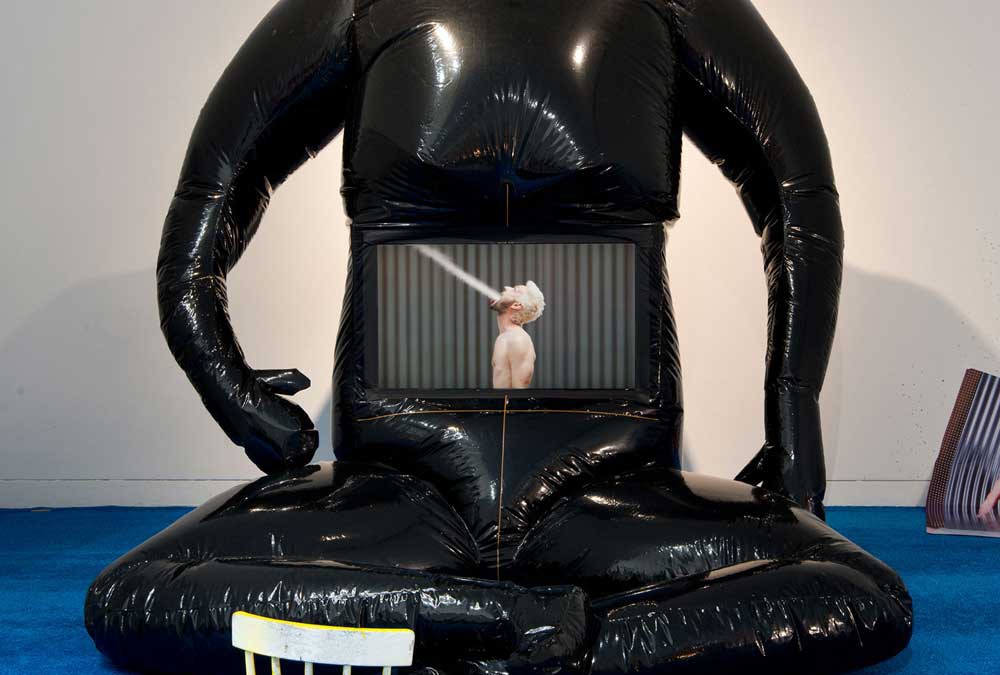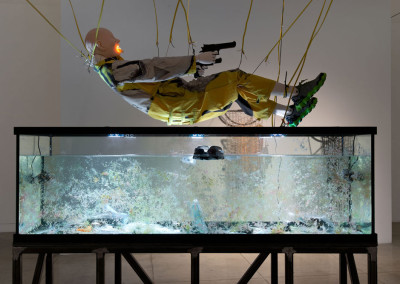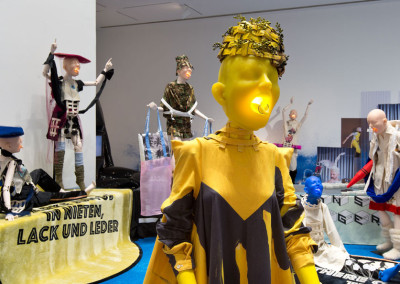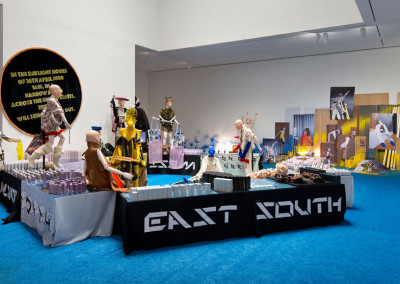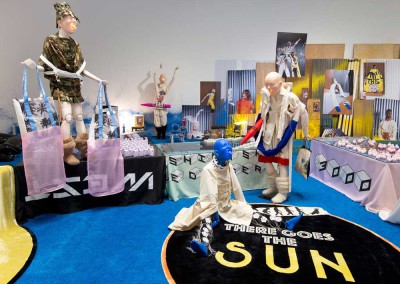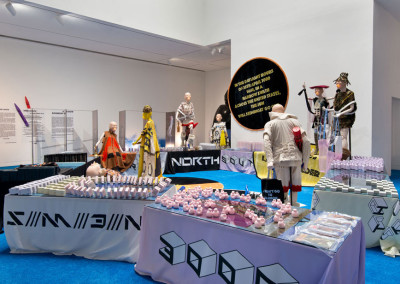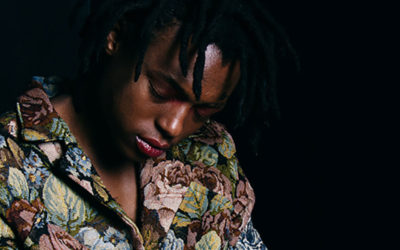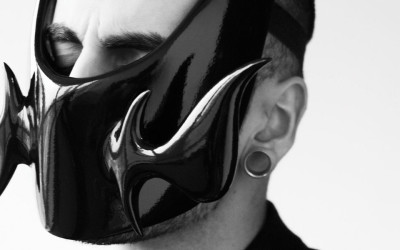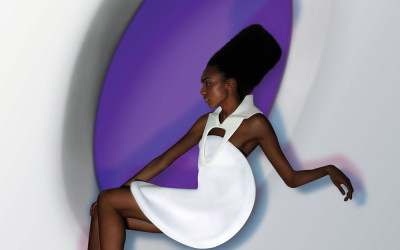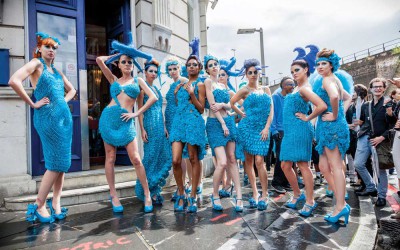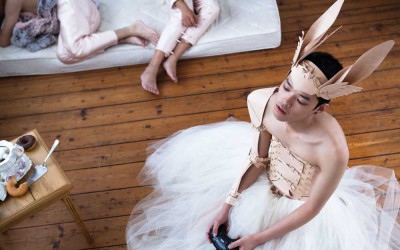Bernhard Willhelm
Text JF. Pierets Photos Courtesy of MOCA
The Museum of Contemporary Art, Los Angeles presents the first American museum exhibition of the work of fashion designers Bernhard Willhelm and Jutta Kraus. Bernhard Willhelm 3000: When Fashion Shows The Danger Then Fashion Is The Danger, is a meditation on the future of commerce and a ‘thinking-forward exhibition’.
The designer sees the show as his response to the uniformity of consumerism in the 21st century as well as a forecast of the fashion experience in the 22nd century. Since the founding of his eponymous label in 1999 with Kraus, Willhelm has been moving in between chaos and diversity. In opposition to the minimalist designs that dominated runways in the 1990s, Willhelm’s designs are characterized by their outspoken visual language, which they transform and combine in an unparalleled way with juxtapositions between high and low culture. We caught Willhelm in a mood to talk about art, asking questions and hard-ons. Needless to say we loved it!
How are you?
Very good! The new collection arrived today.
Happy with the result?
O yes! It looks very experimental. This week I have to finish everything for the show at MOCA. It’s a solo show and we introduce the latest collection, which will also be presented in Paris by the end of the month. A collection about the future of fashion and the future of commerce. It’s about what people project on fashion and how fashion can look into the future.
The show is titled ‘When Fashion Shows The Danger Then Fashion Is The Danger’ and is your response to the uniformity of consumerism in the 21st century. Can you elaborate?
Fashion is a part of life and you have to deal with it. The interesting part of it is that it becomes more and more important. The perception of fashion, what it is versus what it was, has changed completely over the last 10 or 20 years. We all turned into educated consumers, which means that at a very young age we are somehow ‘educated’ on the products we want to buy. Or when it comes to the products that they tell us to buy. LA is therefore an interesting place because they are obsessed with image. It’s a place based on the entertainment industry, with the Oscars as the cherry on the cake. LA has established itself as the new fashion capital, highly important for image making, since those images are transported all over the world.
You relocated the Willhelm-team to Los Angeles. Has it been a big adjustment?
I came here just because of the difference between Europe and America. America is still the promised land but it’s also very doomed, yet for us Europeans, it’s a Franz Kafka kind of doomed. For me it’s maybe the most magical place to be. It brings a lot of new influences and you get new impressions on how Americans are. I’m currently based in Beachwood Canyon, which is exactly where the Hollywood sign is – I actually call it Hollyweed because there is a lot of smoking going on around here. Every morning I take a little hike and I see people posing in front of the sign so I’m actually living on a magic mountain. It’s an experiment: ‘Bernhard goes to Hollywood’.
You talk a lot about experiments.
That’s because each collection is an experiment. We work since 1999 and now people start to see the story, the big picture. Being a fashion designer is going into a cycle. The first seasons you’re the hot new kid on the block. But to hold that presumption and to continue being an actual fashion designer, that is not very easy. What you can see now, is that we have both ‘forward thinking collections’ and ‘experiments’. People do expect that. They come to us for the unexpected, and are gathering recognizable signature pieces from each collection. Compared to most fashion houses, we are not selling so much handbags and accessories, but for us it has always been the experimental products. We are actually selling clothes. Let’s say it’s a specialized group of people who are interested in us.
You are working for over 10 years now, what has changed overtime?
The most significant thing that happened in those 10 years is a certain kind of freedom. I have done Belgium and then Paris. A little bit of Mexico and now I moved the complete team here. I guess the most significant thing is that somehow we are a very free community on how to operate in fashion – The globalization of it all, since the products are produced both in Japan and for a little part in Belgium. The sunglasses are made in Berlin and the shoes are made in Spain. It’s a very abstract way of working since it all comes from different places, yet that’s the exact thing that makes us very free and gives us the possibility to travel. What also changed is that I recently realized that it takes a bit longer than usual to put your face in shape when you are 42.
In the show you give us a vision of an apocalyptic future. The year 3000, an era defined by ecological disaster and climate change. Is it your role as an artist, to ask questions?
It’s the role and beauty of every living person here on earth. If you take everything for granted it would be a little bit too easy.
You’re work is filled with sex and full of fun, but also signed by complexity and anarchism. You can say it’s happy and fucked up at the same time. It may be ironic but there is also a lot of humor involved. I work with different perceptions of what fashion eventually is. What makes you happy, what really pisses you off. There are issues on diversity, sexuality and there are controversial issues. I always think that people who feel that those elements don’t belong in fashion, are actually not preserving enough to be in fashion. Am I good enough to be in fashion? Maybe not. I don’t know. I guess it’s just about asking questions. And am I asking only happy questions? No! That would be too easy. I’m not only here to make people happy. I’m here to ask questions. Whether they like those questions or not, is a superficial side issue.
‘I work with different perceptions of what fashion eventually is. What makes you happy, what really pisses you off. There are issues on diversity, sexuality and there are controversial issues.’
I read you sell the most in Japan? How do you keep your balance towards customers: Japan versus America?
We have indeed a very big Japanese fan base. We even have fans – let’s call it collectors – who are actually putting our clothes on the wall. They are living in it. This is also the thought behind the expo, the question; why is fashion so important that it’s in a museum? So far I have done two museum shows, both in Antwerp and in Groningen. This is actually my 3rd solo show. It also means that I’m doing fashion exhibitions in museums at a young age. That also means that my creations are very much liked as art.But to return to your original question: People here are completely obsessed by fashion. So in a way it’s a bit like in Japan. We also opened a shop here in Beverly Hills and there seems to be the same amount of interest in both places so I don’t have to adjust.
Does fashion belong in a museum?
Fashion is all about decision-making and about how I want to be perceived by people who go to a museum. You also reach a much larger public. People who normally have nothing to do with fashion, go to a museum because they want to see something interesting. And since you don’t want to bore people, you’re giving them a different perception about what fashion can be.
You collaborate with a lot of artists. Is that a must when it comes to your creative process?
Working with artists is about stimulation and inspiration. And appreciation. I have a team that stimulates me because of its group-energy and because those people don’t always agree with me. That energy and that clash of taste is the most important thing when you are a creative person.
You also worked with one of our favorite photographers, Lukas Beyeler, for your 2012 lookbook. Lukas is, among other things, very interested in gay porn stars and drag. How about you?
The gay community is very important to talk to. I talk to them in my own language and they get turned on by it – or I get turned on by it – and that’s already enough. I don’t want to intellectualize porn because porn is just porn. We used porn stars as models to present our collection. For me it was just fashion and image making, it had nothing to do with porn. And maybe by doing that, I’m changing the perception of the porn star. I think that’s very exciting. And eventually I get a hard on. When Bernhard wakes up with a hard on, it’s a very happy day.
Good for you!
It is! Because when there is an erection there is energy. It’s all about stimulation. You don’t want to bore people by being a prude.
What makes your world rock?
My work. Fashion is about decision-making. Whether you have a certain talent or whether you’re good with your hands or your eyes. And since a lot of people are saying that I have that talent, I feel privileged.There are so many people who want to do this job yet so few people have the chance to do so. I got that chance and I consider it a gift.
More crazy, fun and beautiful work on the future wish-list?
Blue jeans and total wealth. I do like the idea of blue jeans with a gold stitching!
Related articles
Lebogang Mokgoko
I think I represent a new wave of creators. We’ve been exposed to the internet, grew up listening to Kanye West, so obviously we’re going to adapt that whole theory of multidiscipline as opposed to doing only one thing. On paper I studied design…..
Rein Vollenga
You can call it ‘wearable sculpture’, if you really want to give it a name. Those who would like to look outside the box a bit might see an attractive work of art, dark yet extremely seductive. Whether he is a sculptor or a milliner, Rein Vollenga is a…..
Peter Popps
Highly experienced shoe professional, Peter Popps, recently released his own amazing line of shoes. As we speak, Lady Gaga is wearing Peter’s CUBE creation during the shoot for ‘ARTPOP’ by Inez Van Lamsweerde and Vinoodh Matadin. An interview…..
Paul Boudens
Originally, Paul Boudens wanted to become a fashion designer when he first set foot in Antwerp. Yet fate decided differently (he flunked his entrance exam) and nowadays he’s one of the most wanted graphic designers working together with the…..
Pierre Garroudi
His intricate designs merge the lines between art & fashion and have been worn by some of the world’s biggest style icons from Naomi Campbell to Kate Moss, Scarlet Johansson and Sarah Jessica Parker. He walks the streets of London with his…..
Niels Peeraer
“I’m confused, I’m sitting here on the sofa, the heart my boyfriend drew on the mirror is still there, my heart in a rice cooker. I think I’ll marry him again at lunch. My cat is sleeping but it’s already been 4 days. Well, I have to go to the supermarket…..
Clare Whittingham
Some describe her work as being “darkly comic, satirical and empowering” but since she commissioned a piece for Lady Gaga, her work has become metalwork must-haves. In between art and fashion, she transforms scrap metal into wearable…..
